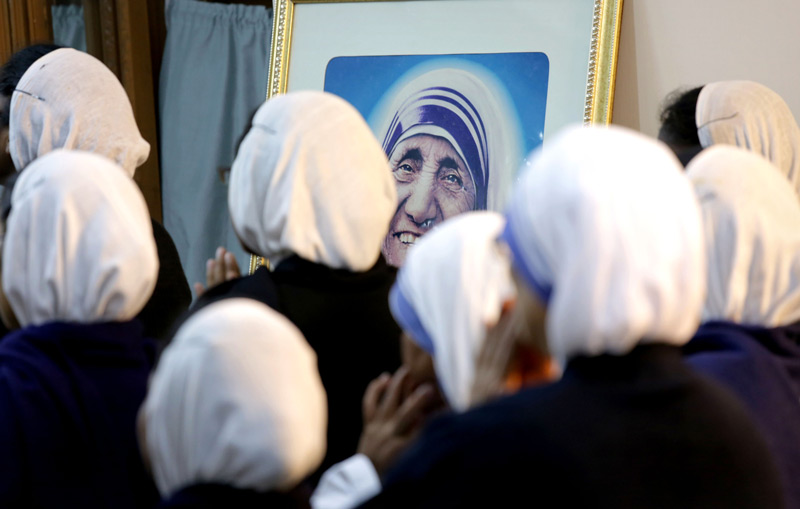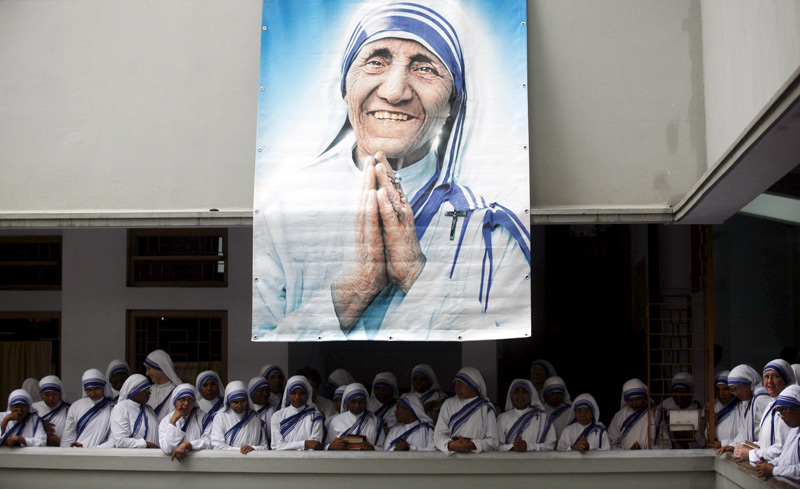Editor’s note: William Frei, a seminarian for the Diocese of Charleston, shares his experiences volunteering in Kolkata, India.
Mother Teresa, Kolkata, and the poor cannot be separated
When I asked Sister Paulina, the superior of Dono di Maria — the house of the Missionaries of Charity in Vatican City — to pray for me, that I might be given light as to how to approach writing this piece, she responded by saying, “You must write about Mother Teresa, Kolkata, and the poor. These three cannot be separated.”
If I have learned anything during my time volunteering at Dono di Maria, following my four-week mission experience in Kolkata last summer, it is this: When it comes to anything spiritual, Sister knows best. This is because her very life is one lived in close proximity to God. She does not so much put the fear of God in you, as transform any fear into a great love, or thirst, for Him. And so, this piece is about my experience of getting to know Mother Teresa, the city of Kolkata, and the poorest of the poor.

“Put your hand in His hand, and walk alone with Him.”
These are the parting words from the mother of 18-year-old Gonxha Agnes Bojaxhiu, the future Mother Teresa, as she left her home in Skopje, in the Republic of Macedonia, to begin her life as a missionary.
In those days, when someone went to the missions, she never saw her family again (today, the Missionaries of Charity can visit their family once every 10 years).
On Sept. 26, 1928, Mother Teresa journeyed to Ireland, where she joined the Institute of the Blessed Virgin Mary (the Loreto Sisters), a non-cloistered congregation of women religious who dedicate their lives to education. She then applied for the missions in Bengal, India, and arrived in Kolkata in 1929. She was appointed to teach at St. Mary’s Bengali Medium School for girls, where she taught until 1948 — the year she left Loreto to establish the Missionaries of Charity.

Two important moments in Mother Teresa’s life occurred during this time. The first was when, after almost 11 years of faithfully living her vow of obedience as a Loreto Sister, she made a private vow “to give God anything that He may ask — Not to refuse Him anything” — choosing to be considered accountable “under pain of mortal sin.”
The second was when, while taking a train to Darjeeling on Sept. 10, 1946, for her annual retreat, Mother Teresa received her “call within a call” to “satiate the thirst of Jesus on the Cross” by serving the poorest of the poor in Kolkata. It was from Jesus that she received this call, and from Jesus that she received a series of locutions (supernatural words). By way of these locutions, Jesus Himself described what sort of religious order He wanted, so much so that the essential aspects of Mother Teresa’s spiritual vision and way of life of the new religious order was settled by the time she left Loreto. From this “day of inspiration,” as Mother Teresa called it, came the establishment of the Missionaries of Charity throughout the city of Kolkata, throughout India, and eventually, throughout the world.
I grew to better know Mother Teresa during my time in Kolkata by praying before her tomb each morning after Mass with the sisters and volunteers at the motherhouse. Her tomb is made of simple, white stone, with the tombstone reading, “Mother M. Teresa M.C., Our Dearly Beloved Mother Foundress of the Missionaries of Charity.”
Praying before her tomb was always a powerful experience, but one exceptionally powerful moment was when I was praying with Sister Mary Prema, the current superior general of the Missionaries of Charity.
Sister Prema met Mother Teresa in 1980 and was inspired to join after reading a biography of the foundress. I noticed that Sister Prema prayed as though she was talking to an old, dear friend, causing the veil between this life and the next to seem almost translucent in that moment.
I also grew to better know the saint by working with her sisters, both at Nirmal Hriday — Mother Teresa’s home for the sick and dying destitute — and at Daya Dan — a home for physically and mentally handicapped children. At these two homes, the sisters were always joyful, loving, and caring, both toward their patients and the volunteers. Mother Teresa’s spirit is very much alive in her Missionaries of Charity.

“That stupid crow — I can hear it well.”
I saw a lot more than a “stupid crow,” as Mother Teresa once put it, during my time in Kolkata (the full quote is: “That crow is praising God. That stupid crow — I can hear it well. We can see and hear God in that crow, but we cannot see and hear him if our heart is not clean”).

Along with large crows, I saw countless numbers of stray dogs, city rats, cows and water buffaloes roaming the streets, and pigs in the slums. Only once did I see a dog on a leash with a clean, well-groomed coat, and it actually seemed out of place.
There were frequent piles of trash on roadsides, which were set on fire in the early morning hours in order to manage waste. In fact, because of the trash, as well as the many food stands selling meats, spices, fruits and vegetables, the city itself had a smell. I remember one day stepping outside to wash laundry in a bucket and then hanging it on a clothesline to dry. When I stepped back inside, I realized that the clothes I was wearing had picked up the smell of the city (in much the same way that the smell of a campfire sticks to your clothing, though the campfire smell is much less pungent).
I also saw rickshaws and bicycles, tuk-tuks and taxis, scooters and motorcycles, cars and buses, trains and a metro rail. But what I saw most in Kolkata were people, lots of people. Kolkata has a population of 4.6 million people in an area of 71 square miles. New York City has twice the number of people, but in an area more than four times as large. Roughly 79 percent of the population is Hindu, 20 percent is Muslim, and 1 percent is Christian.
All of this to say that Kolkata was the loudest, dirtiest, smelliest, and most overpopulated city I have ever visited, and it now is one of my favorite places on Earth. Mother Teresa loved the city and the people in it; however, this city is also very near to the Lord’s heart, as it was here that He called Mother to found the Missionaries of Charity. Knowing this has made my own love for the city and its people grow.

“Whatsoever you do to the least of my brethren, you do it to me” (Mt 25:40)
Mother Teresa truly took this verse from the Gospel of St. Matthew to heart, as do the Missionaries of Charity Sisters today. She saw Christ in the poorest of the poor and for this reason, she and her sisters set out “to labor at the salvation and sanctification of the poorest of the poor not only in the slums but all over the world.”
Her sisters accomplish this by nursing the sick and the dying destitute; gathering and teaching street children; visiting and caring for beggars, leprosy patients, and their children; giving shelter to the abandoned and homeless; caring for the unwanted, the unloved, and the lonely; going out to proclaim the Word of God by their presence and spiritual works of mercy; and by adoring Jesus in the Blessed Sacrament.
Mother Teresa understood that “a missionary is one sent with a mission — a message to deliver,” and the message that she and her sisters have to deliver is God’s love. To have seen the Missionaries of Charity Sisters delivering this message each day during my time in Kolkata is something almost too beautiful to express in words.
So many times, the care, the concern, and the love that I saw the sisters give reminded me of the care a mother shows toward her child. Men, women, and children truly on the fringes of society — the destitute, the dying, the sick, the unwanted, the unloved — were cared for by these spiritual mothers, who received the poorest of the poor as their own spiritual children. The sisters see them for who they really are, Jesus in His most distressing disguise, and restore their dignity by delivering to them the message of God’s love.
We, in the Diocese of Charleston, can take Sister Paulina’s words and, with a bit of tweaking, make them our own. She told me that Mother Teresa, Kolkata, and the poor cannot be separated.
However, we can say that Mother Teresa, Kolkata, and the poor cannot be separated from our hearts.
Although many of us will not have the opportunity to volunteer with the Missionaries of Charity Sisters in Kolkata, we can still share in her mission, indeed, in Christ’s mission, by caring for the poorest of the poor in our own diocese, by delivering the message of God’s love to those most in need, remembering that they are, in truth, Jesus in disguise.
St. Teresa of Kolkata, pray for us!
Featured photo: Provided: Will Frei, a seminarian currently studying in Rome, shares treats with children during his mission time in Kolkata, India.



